Like just about every surf angler I know I’ve often stood at the water’s edge and wondered what the fishing would be like on the other side of the breakers, well out of my casting range.
I knew keen anglers had been chasing mackerel and other pelagic species on kayaks and surf-skis off Palm Beach and other Gold Coast beaches for over thirty years. I was also aware that kayaks and skis had been used for fishing on the Sunshine Coast for many years and that some magnificent catches including large mackerel, tuna, and snapper had been made offshore from Noosa through to Caloundra.
It wasn’t until last summer, however, that I finally invested in a kayak suitable for surf launching and I am now starting to find out for myself just how good the fishing can be beyond the breakers.
Kayak anglers who regularly launch from our beaches are well aware of the difficulty (and danger) in crossing the surf line. Many had a long history in surfing on boards or skis well before they ever contemplated taking a kayak rigged for fishing into the surf. The old-timers made it look so easy, but after a couple of early experiences where I was flipped over backwards while trying to cross large surf on an open beach I now carefully look at wind, wave and swell direction forecasts when planning a beach launch.
If I think places like Palm Beach might be too rough, then I will choose a more protected venue such as Mooloolaba or, if the wind is too strong or the waves are too high, then I will simply cancel the trip. When conditions are marginal it is bad enough to damage fishing equipment let alone to risk personal injury by being dumped in rough conditions.
Of course, even in small surf, kayaks have a tendency to broach when running with a wave and an embarrassing capsize is always on the cards even in less than 1m of water as you reach the beach so I always wear a PFD and make sure my fishing equipment is stowed in hatches or securely attached to the deck with no hooks, knives, or gaffs around to snag on my clothing or myself.
Tailor, mackerel, tuna, snapper and many other species can be taken by trolling hard-bodied or soft plastic lures behind a kayak near where fish are visibly feeding or birds are working and metal slugs can be used if you can get close enough to cast to a surface boil of tuna or mackerel. Some of my colleagues even prefer to jig their own live bait and have had considerable success in converting the livies into mackerel, tuna, cobia, and other large predators.
I mainly use 10kg mono line to slowly troll or drift a pilchard on 4-ganged or 3-ganged 4/0, 5/0 or 6/0 hook set fitted with the ever popular pink octopus skirts. I find that just a slow paddle keeps the rig mid water. When I end up fishing near a group of powerboats I’ve noticed that my ideal trolling speed is slightly slower than the slowest speed that most powerboats are able to maintain.
Even if you want a wide variety of fishing tackle options, there is limited space on a kayak and you can’t take every lure and a selection of baits like you can on a boat. I pick what I believe is the minimum to do the job when packing the night before and this usually means I take a few pillie rigs, one metal slug, and a couple of hard-bodied or soft plastic lures. Even with this minimal choice I reckon it’s easier to stick with pillies rather than change tactics all the time. Once my small pack of 6-8 pilchards is all gone then it’s usually time to head for home with one of the lures in tow.
Provided the fish are feeding within paddling distance of the shore, I believe the stealth of the kayak gives kayak fishers more opportunity to connect to a fish without spooking the school and that this gives kayakers more chance than boaties have when using the humble pillie.
I’m happy just to catch one or two good fish and head for home before the wind comes up too strongly. In summer, if I don’t have any fish on board by 7am then I don’t expect to be having fish for dinner that day and I head for shore. Even if I do catch a fish or two, by 7am I am starting to get a bit weary and am ready to get back on to dry land.
Once a large fish has been hooked then the true kayak fishing experience kicks in. The reel-screaming runs of mackerel and tuna are enhanced by the exhilaration of being towed in a straight line or around in circles when a fish close to the kayak goes deep. Because you don’t want a toothy critter going ballistic on the deck between your legs it is essential to thoroughly tire out your quarry before it is gaffed or tailed and dragged aboard. In my short offshore career I’ve found this process to take from several minutes for keeper mackerel up to 15 minutes for medium sized tuna. There are, however, several experienced kayak fishers around SEQ who have had battles of well over an hour to subdue much larger fish than I have as yet been able to latch on to.
Fishing offshore from an open surf beach in a kayak has inherent risks and appropriate safety procedures should be followed prior to and during the trip.
Firstly, consider the weather and simply cancel the trip if conditions are unsafe or marginal.
Secondly, carry sufficient safety equipment to cover all potential problems. In my case I always wear a PFD and carry a portable waterproof VHF radio as well as an orange smoke flare, V-sheet, signalling mirror, water, food, knife, pliers, torch, and mobile phone in a waterproof container.
I always let someone know where I will be going and when I expect to return and, if fishing on my own, I log on and off via VHF radio with the local Coastguard station. I, and a growing number of kayakers, have joined our local Coastguard or VMR flotillas and have enrolled for MROCP (Marine Radio Operator’s Certificate of Proficiency) courses. The value of the annual membership fee would be more than recouped after only one rescue from your local group.
Another potential risk (or phobia maybe) I personally have tried to address is risk from sharks and, whenever kayak fishing offshore, I deploy an electronic Shark-Shield device which was developed to repel sharks by creating an electric field that they detect and dislike via their inbuilt receptors. I take solace in the fact that this device has been widely tested in South Africa as well as South Australia but am yet to find out whether it actually works in the waters I frequent (my wife tells me that she has the receipt and will ask for her money back if it doesn’t).
Even though I’ve fished all my life, there have been few fishing experiences that have given me as big a rush as I get when I connect to a decent fish from a kayak and enjoy the sensation of being towed long distances during the process of playing the fish.
Therefore, I think the necessary effort to hit the beach at dawn, paddle out to the fishing grounds, and to occasionally get dunked whilst launching or landing, is more than recompensed by the exhilarating feeling you get every time you hook onto and eventually land one of the offshore speedsters that have living on our doorstep in SEQ.
Reads: 6880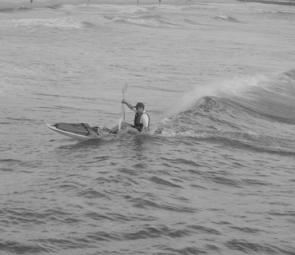
Some days launching and landing is the hardest part.
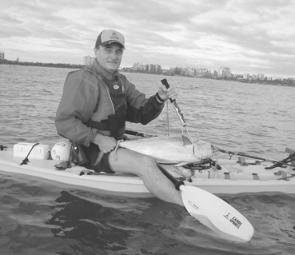
The author with mack tuna taken by a pink-skirted pilchard on ganged 6-O.
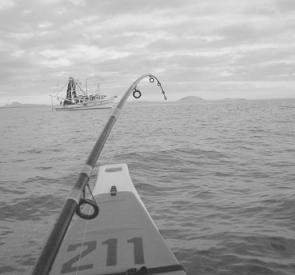
When getting towed by a tuna, you've got to hope it heads away from other craft.
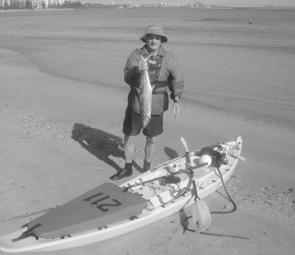
The author with a spotty mackerel, the ideal target for offshore kayak fishers.
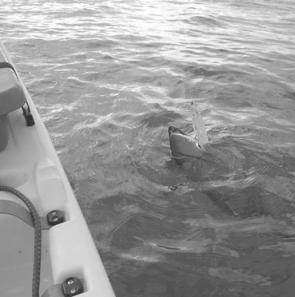
It can take quite a while to get to this stage where a tuna is resting beside the boat ready to be landed. And that is what the fuss about offshore kayaking is all about.




